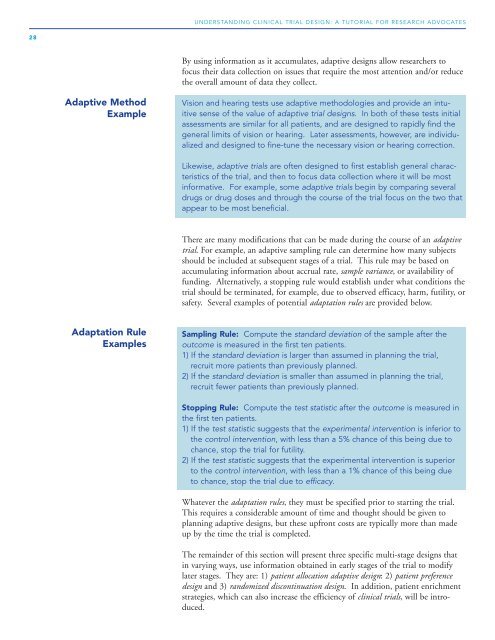Understanding Clinical Trial Design - Research Advocacy Network
Understanding Clinical Trial Design - Research Advocacy Network
Understanding Clinical Trial Design - Research Advocacy Network
Create successful ePaper yourself
Turn your PDF publications into a flip-book with our unique Google optimized e-Paper software.
28<br />
Adaptive Method<br />
Example<br />
Adaptation Rule<br />
Examples<br />
UNDERSTANDING CLINICAL TRIAL DESIGN: A TUTORIAL FOR RESEARCH ADVOCATES<br />
By using information as it accumulates, adaptive designs allow researchers to<br />
focus their data collection on issues that require the most attention and/or reduce<br />
the overall amount of data they collect.<br />
Vision and hearing tests use adaptive methodologies and provide an intuitive<br />
sense of the value of adaptive trial designs. In both of these tests initial<br />
assessments are similar for all patients, and are designed to rapidly find the<br />
general limits of vision or hearing. Later assessments, however, are individualized<br />
and designed to fine-tune the necessary vision or hearing correction.<br />
Likewise, adaptive trials are often designed to first establish general characteristics<br />
of the trial, and then to focus data collection where it will be most<br />
informative. For example, some adaptive trials begin by comparing several<br />
drugs or drug doses and through the course of the trial focus on the two that<br />
appear to be most beneficial.<br />
There are many modifications that can be made during the course of an adaptive<br />
trial. For example, an adaptive sampling rule can determine how many subjects<br />
should be included at subsequent stages of a trial. This rule may be based on<br />
accumulating information about accrual rate, sample variance, or availability of<br />
funding. Alternatively, a stopping rule would establish under what conditions the<br />
trial should be terminated, for example, due to observed efficacy, harm, futility, or<br />
safety. Several examples of potential adaptation rules are provided below.<br />
Sampling Rule: Compute the standard deviation of the sample after the<br />
outcome is measured in the first ten patients.<br />
1) If the standard deviation is larger than assumed in planning the trial,<br />
recruit more patients than previously planned.<br />
2) If the standard deviation is smaller than assumed in planning the trial,<br />
recruit fewer patients than previously planned.<br />
Stopping Rule: Compute the test statistic after the outcome is measured in<br />
the first ten patients.<br />
1) If the test statistic suggests that the experimental intervention is inferior to<br />
the control intervention, with less than a 5% chance of this being due to<br />
chance, stop the trial for futility.<br />
2) If the test statistic suggests that the experimental intervention is superior<br />
to the control intervention, with less than a 1% chance of this being due<br />
to chance, stop the trial due to efficacy.<br />
Whatever the adaptation rules, they must be specified prior to starting the trial.<br />
This requires a considerable amount of time and thought should be given to<br />
planning adaptive designs, but these upfront costs are typically more than made<br />
up by the time the trial is completed.<br />
The remainder of this section will present three specific multi-stage designs that<br />
in varying ways, use information obtained in early stages of the trial to modify<br />
later stages. They are: 1) patient allocation adaptive design: 2) patient preference<br />
design and 3) randomized discontinuation design. In addition, patient enrichment<br />
strategies, which can also increase the efficiency of clinical trials, will be introduced.


